The Friendly Fire Room Presents
Listen And See
Thank you Wanda Barlow for this great idea!
Pronouns Metaphors Errors Pt 14
Pronouns Metaphors Errors Pt 14
To God be the Glory, great things He has done.
mcmtffr.org wishes to acknowledge and thank Derek Konofalski and Rocket Media for making this page:
Mobile Friendly
Message
January 25, 2015
Part 14
Today we will complete our look into:
- the figure, ”the blood of Christ” used in Scripture.
- what is the intended meaning of this figure.
- what this figure should call to our minds.
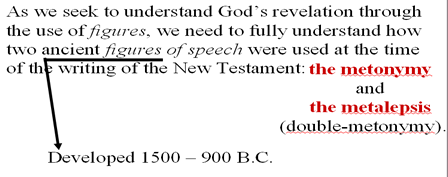
By the way, since we should not burden ourselves with complex terminology whenever avoidable; after a few slides, we will completely scrap the term metalepsis, and just say “double-metonymy”.
Let’s begin our examination of the double-metonymy“the blood of Christ”. Arranged together, the following structure represents the syntax of the double-metonymy, and for the figure “the blood of Christ”: syntax: the blood{ x ( y )} of Christ
Please take a closer look.
syntax: the blood{ x ( y )} of Christ
Remember our visual demonstration characterizing the metonymy and the double-metonymy?
box #1{ } of Christ
I coined this syntax to symbolically represent the nested relationship of three named boxes, demonstrating how box #3 (the box we actually expected) is contained in box #2, and box #2 (including #3) are included in box #1.
The figure, “the blood of Christ”, consists of three
elements (boxes = words), including two stages of
relationship with one another: “
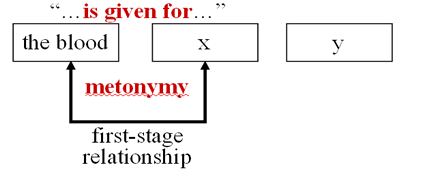
The figure, “the blood of Christ”, consists of three
elements (boxes = words), including two stages of
relationship with one another:

The figure, “the blood of Christ”, consists of three
elements (boxes = words), including two stages of
relationship with one another:
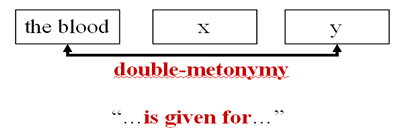
In a given metonymy, just as with a math expression, it is always up to us to evaluate the information we are given, in order to determine the identity of x and y.
In fact, this is a requirement all figures of speech have in common with one another; once the reader has discovered he is dealing with a figure of speech in the text, it is his responsibility to evaluate the information given him, in order to determine the writer’s original intent for the figure.
Today, I’m first going to skip to result of the evaluation process required to identify the words x and y, so as to decipher our double-metonymy,“the blood of Christ”. After that I intend to help you learn how to think through the mental processes required to arrive at valid answers, and how to practice to become proficient at deciphering metonymies for yourself.
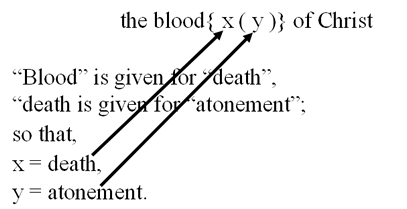
Solution: “the blood{ death( atonement)} of Christ” This double-metonymy is a very powerful figure of speech.
Notice there’s a whole lot going on within this double-metonymy. While “blood” is given for “death”, a special kind of relationship exists between the words “blood” and “death”. The relationship is not one of “representation” as with the metaphor, nor is it one of “resemblance” as with the simile; the word or noun of the metonymy figure is used instead of another word, to which it stands in a certain kind of relation.
I had been searching for a single-key-word to clearly describe the kind of relationship involved, and I finally found it: the special kind of relationship between the words of metonymies is one of“affinity”! In order for the relationship between nouns to qualify as a metonymy, and not a metaphor, nor a simile, there must be a certain, easy to recognize, “affinity” between them.
(Q) What does affinity mean?
(A) …a natural accord with, in harmony with, in a close relationship with. A few synonyms come close to describing this kind of relationship; namely, kinship, association, link, and correspondence.
If you are technically inclined, it might help to say that a metonymy requires “a semantic affinity between the two words”. So, the link, the affinity, the critical relationship between blood and death, not only speaks to the fact that blood-shedding contributed to His death, but that His death was characteristically a blood-shedding kind of death.
We cannot stop here. While “blood” is given for “death”, and a special kind of relationship exists between the words “blood” and “death”; in turn, “death” is given for “atonement”, and a special kind of relationship also exists between the words “death” and “atonement”. The affinity relationship between death and atonement, not only speaks to the fact that the death of Christ contributed to the perfect satisfaction of payment for the sins of those He came to save, His atonement was characteristically a death-merited kind of atonement which was required by God, death which He bore in our place, to fully-pay for the debt of our sins.
When we read the words “the blood of Christ”, it should trigger the words, “death”, and especially “atonement”.
About now you should be asking- (Q) Why should anyone use a double-metonymy, why not simply use a single metonymy?
(A) When the logical gap of affinity between two nouns appears to be semantically too wide for a single-metonymy, we can safely operate on the logical assumption that the writer originally intended to use a two-stage metonymy. In this particular instance, when you think about it, it is easy to see a wide semantic gap between “blood” and “atonement”, which is easily bridged by the word “death”. So why not just put “death” for “atonement”? Because the thought of blood gets our attention more than the thought of death; it’s also why stop signs, fire engines, etc. are red. Psychologically, the color red alarms us just as does spilt blood.
OK, we need to at least look at the English
translation of the term for the double-metomymy: ![]() metalepsis.
metalepsis.
The compound term metalepsis in Greek properly means: lepsis- “the act of leaving out a necessary portion” meta- “having association with”. That seems like quite a challenge for a writer:“leave out a necessary portion of some words having an association with other words”, and still have the expression understood by his reader. “To omit a necessary portion” sounds like a paradox; that is, something which seems contradictory, but is nevertheless holds true.
We have just seen how the words, relationships and associations that have been omitted in this expression by the writer, must be supplied by the reader’s mental process, because they constitute a necessary part in order to understand the writer’s expression.
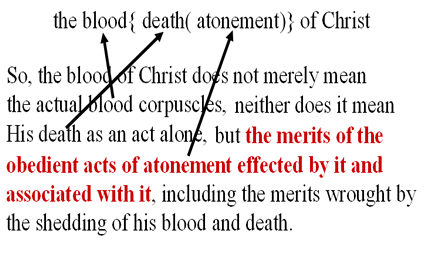
For example…
Romans 3.25
“Through faith in His blood”:
(Q) How should we then think of this expression?
(A) “through faith in the merits of the atonement accomplished by His blood, where His blood is related to His death and atonement in an all-inclusive relationship of two stages; blood to death, and death
(Q) How should we then think of this expression? to atonement.”
(A) “through faith in the merits of the atonement accomplished by His blood, where His blood is related to His death and atonement in an all-inclusive relationship of two stages; blood to death, and death to atonement.”
Romans 5.9
“Being now justified by His blood”:
i.e., by His blood, His death, and His atonement, inclusively, by affinity.
Ephesians 1.7
“Redemption through His blood”:
i.e., by affinity, through the instrumental means of the merits of His atoning death and blood-shedding.
In each of these examples of Scripture, we need to understand that the word “blood” cannot be said to“represent” the words “death” and “atonement”. A word that is used to “represent” is the work of the metaphor, not the metonymy.
A metaphor is a word that “stands in the place” for another word through “representation”.
Think of a picture of someone placed on their desk-chair. The picture is not a necessary part of the person, nor is it a direct link to them by any relationship of affinity.
The picture does not connect with the person in a relationship of affinity. You are looking at a representation of the person.
A metonymy is a word that “connects” us to another word through a “relationship of affinity” or “close association”.
Think of a person sitting in their desk-chair. The person is your uncle Bill, but the nameplate on his desk says Dr. William Tell.
The character of the way you will relate to this man
today will be determined by your choice of the name
change for “the man”, either “uncle” or “doctor”. If “uncle” is given for “this man”, it means you
intend to relate to him in your conversation which
will include will things having an affinity with“uncle ways”.If “doctor” is given for “this man”, you intend to
relate to him in your conversation in terms having
an affinity with “doctor ways”.Either name, “uncle” or “doctor” implies necessary
parts of the person, each having its own characteristic
affinity with “the man”.
A metaphor is a word that “stands in the place” for another word through “representation”.
A metonymy is a word that “connects” us to another word through a “relationship of affinity” or “close association”.
If “blood of Christ” is given for “death( atonement) of Christ”, the writer of Scripture intends for you to relate to the blood of Christ in ways that include the affinity that His blood and His death have (especially) with His atonement.
Many will be surprised on the Day of Judgment
when they discover
that it was just as the Word of God says;
only the righteousness of Christ is able to save you.All men are sinners and no one can save himself.
God is just, so He must punish sin;
but He is also merciful, moreover gracious,
and offers His Son as the perfect sacrifice
in order to purchase a place for you in heaven,
which He offers to you as the free gift of eternal life.Jesus is the Christ, the Messiah,
the Anointed One, He is God Incarnate.
In order to pay the debt of our sins,
He came from Heaven, having been sent by the Father,
where He lived a life of perfect obedience to the Father
even unto the shameful death upon the cross
in order to pay the debt of your sins.This gift must be received by faith,
believing that Jesus’ perfect life and Cross Work
was His complete and necessary Atonement
for your sins, in your behalf.
Faith is a gift that comes by the Power of God the Holy Spirit working in a person’s innermost being.
Only the power of God can open your heart to the willingness to have the void within it filled
with the presence of Christ by His Spirit.The Holy Spirit has the authority and power to quicken your dead spirit, to make it come to life.
Only the life of His Spirit’s quickening of your heart will allow the Gospel message of salvation to even make sense to you, to truly “hear” the message and give you the ability,
as the Holy Spirit bears witness to Jesus,
to recognize your need for forgiveness and restoration, and gain the desire of your heart to be favorably inclined to want to receive Christ as your personal Lord and Savior.If you have not done so before this moment,
ask Jesus to forgive you your sins,
tell Him you’ve stop trying to be your own savior,
and ask Him to come into your life right now,
and to give you eternal life. Then, in faith believing,
thank Him for the gift that He is giving you,
the one He paid for in full in your place,
in Jesus’ name,
AMEN
Copyright January, 2015
Rev. Jim Craig
All Rights Reserved
Bibliography
Agnes, Michael and Charlton Laird (eds.). Webster’s New World Dictionary and Thesaurus. New York, NY: Macmillan, 1996.
Aland, Kurt, Matthew Black, Carlo M. Martini, Bruce M. Metzger, and Allen Wikgren (eds.). The Greek New Testament, 4th rev. ed. Germany: Biblica-Druck, 1994.
Benner, Jeff A. The Ancient Hebrew Lexicon of the Bible. College Station, Texas: Virtualbookworm.com Publishing Inc., 2005
Bullinger, E. W. Figures of Speech Used in the Bible; Explained an Illustrated. Grand Rapids, Michigan: Baker Book House, 2007.
Chapman, Benjamin. Greek New Testament Insert. Grand Rapids, Michigan: Baker Book House, 1977.
Dana, H. E., and Julius R. Mantey. A Manual of the New Testament. Canada: The Macmillan Company, 1957.
Louw, Johannes P. and Eugene A. Nida. Greek-English Lexicon of the New Testament Based on Semantic Domains. New York, NY: United Bible Societies, 1989.
The ESV Study Bible. Wheaton, Illinois: Crossway, 2011.
Metzger, Bruce M. Lexical Aids for Students of New Testament Greek. Princeton, New Jersey, 1977.
Wikipedia contributors. "Xenophon." Wikipedia, The Free Encyclopedia. Wikipedia, The Free Encyclopedia, 15 Aug. 2014. Web. 19 Aug. 2014.
Wuest, Kenneth S. The New Testament; An Expanded Translation. Grand Rapids, Michigan, 1992.
Wuest, Kenneth S. (Revised, Donald L. Wise). The Practical Use of the Greek New Testament, rev. ed. Chicago, Il: Moody Press, 1982.
Walsh, J. Martyn and Anna Kathleen Walsh. Plain English Handbook: A Complete Guide to Good English, 7th rev. ed. Cincinnati, Ohio: McCormick-Mathers PublishingCompany,1977.